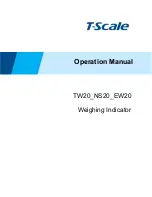
5-16
IM WT5000-01EN
Computing the Motor Efficiency and Total Efficiency
This instrument can compute the motor efficiency (the ratio of power consumption to motor output) and total
efficiency from the active power and motor output that it measures.* You can set the efficiency equation using
the η Formula setting.
* The total efficiency is the ratio of total power consumption—not just the power consumption of the motor but
also the power consumption of the converter that supplies the motor with power—to motor output.
The following is an example of how the values are computed.
When the Motor Input Is Wired to ΣA
×100
Motor output Pm (W)
P
Σ
A(W)
Motor efficiency (%)
Motor
Motor output Pm
Motor power
consumption
P
Σ
A
When the Converter and Motor Inputs Are Wired to ΣA and ΣB, Respectively
×100
Motor output Pm (W)
P
Σ
B(W)
Motor efficiency (%) =
×100
Motor output Pm (W)
P
Σ
A(W)
Total efficiency (%) =
Converter
(inverter, etc.)
Motor
Motor
output
Pm
P
Σ
B
P
Σ
A
Motor power
consumption
Motor and converter
power consumption
When the Converter and Motor Inputs Are Wired to ΣB and ΣA, Respectively
×100
Motor output Pm (W)
P
Σ
A(W)
Motor efficiency (%) =
×100
Motor output Pm (W)
P
Σ
B(W)
Total efficiency (%) =
P
Σ
B
Motor and converter
power consumption
Converter
(inverter, etc.)
Motor
Motor
output
Pm
P
Σ
A
Motor power
consumption
If ΣA or ΣB is a three-phase, three-wire (3P3W) system, you can use
to perform
3P3W>3V3A transformation on ΣA and ΣB. From the 3P3W>3V3A transformation, you can determine one
unmeasured line voltage and one unmeasured common mode current.
5 Motor Evaluation and Auxiliary Input (Option)
















































